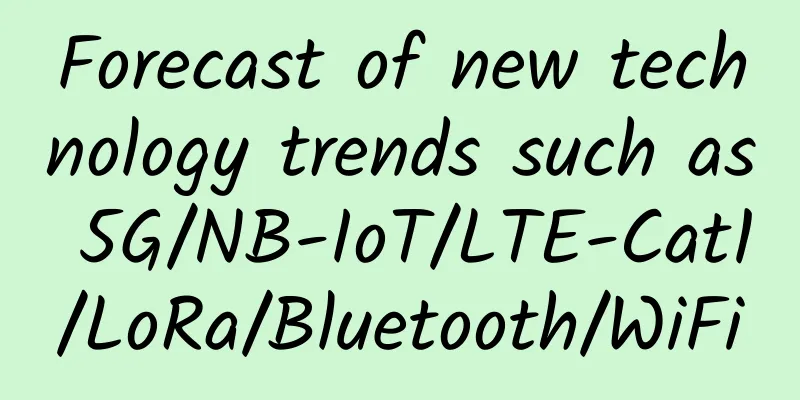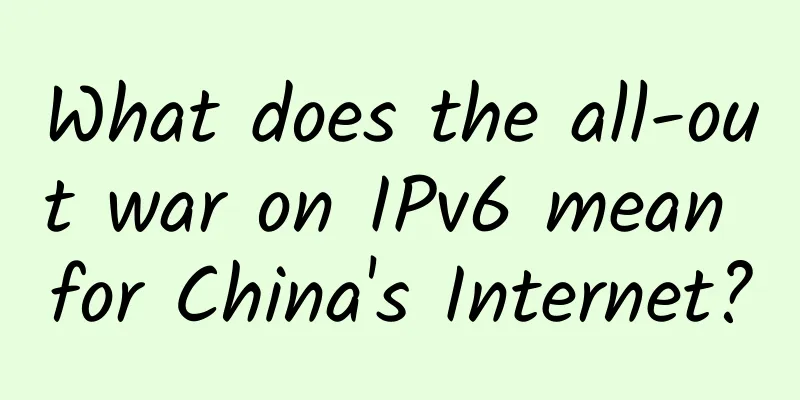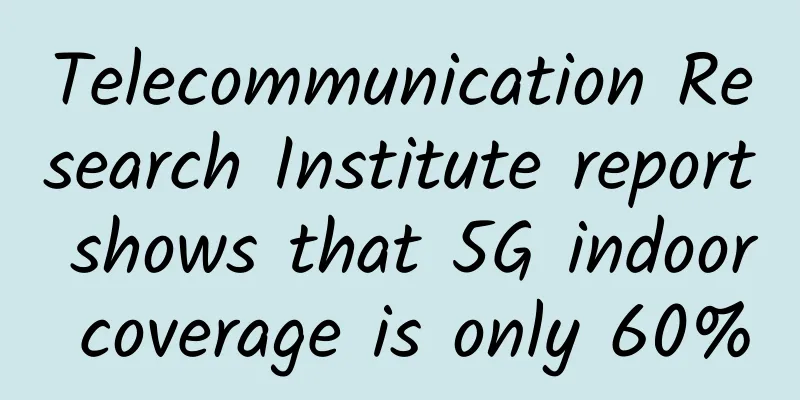Forecast of new technology trends such as 5G/NB-IoT/LTE-Cat1/LoRa/Bluetooth/WiFi

|
Regarding the Internet of Things, the importance of achieving connection is self-evident. "Things" are the foundation, and "connection" is the key. Some form of connection is the prerequisite for data exchange between objects, and to achieve connection, communication technology is needed. Connection can be wired or wireless. However, wired connection is inherently unsuitable for complex large-scale Internet of Things, so wireless connection is the key to the Internet of Things. The development of wireless communication technology will be the driving force behind the Internet of Things, and it is also the fastest-growing and most widely used communication technology category in recent years. Compared with traditional communication technology, the biggest advantage of wireless communication technology lies in its breakthrough in time and space, less interference and influence from external factors, higher information security, greatly improved communication efficiency, and the ability to achieve timely and effective transmission of information. Unlike in the past, the industry's discussion on IoT communications mainly focused on technical characteristics, standard construction, policy support and other aspects. By 2020, IoT communications have entered the stage of application cases being implemented and even large-scale commercial use, so the core of the discussion has shifted to commercial use. This article will analyze the short-term development of several major IoT communication technologies currently in the domestic market, such as 5G, NB-IoT, LTE-Cat1, LoRa, Bluetooth, WiFi, etc.: 5G
According to IHS Markit's forecast, global real GDP will grow at an average annual rate of 2.9% during the period 2020-2035, of which 5G will contribute 0.2%. During this period, 5G will contribute an annual net value of $2.1 trillion to annual GDP, which is equivalent to the annual GDP of India, the world's seventh largest economy. This forecast is inseparable from the real commercialization of 5G, which is also the most noteworthy aspect of 5G. The development of 5G in my country will achieve a transition from small-scale commercialization in 2019 to large-scale commercialization in 2020. The pan-entertainment industry will be one of the first industries to benefit from the development of 5G. In terms of pan-entertainment, under the existing network, the deep integration of live broadcast technology with VR and AR is still lacking, and in the future with the support of 5G, the implementation of live broadcast applications will be faster. In addition, since last year, relevant mobile phone manufacturers such as Huawei, OPPO, vivo, Xiaomi, Samsung, etc. have successively released 5G smartphones. 5G mobile phones have truly opened the prelude to commercialization, and in the future there will be more mobile phone-related companies joining this army. Based on this, mobile games will also grow rapidly and mature industries. Thanks to the development of 5G, its interoperability will have a qualitative leap. 5G has a huge impact on online education, telemedicine, and remote work. Facing the "hell mode" that started in 2020, people have deeply realized the rigid demand for online education, telemedicine, and remote work at the beginning of the year. After this experience, this series of applications may usher in greater development, and new industry opportunities are emerging. NB-IoT
As of now, NB-IoT has completed coverage in more than 300 cities across the country, the number of terminal connections has exceeded 60 million, and the number is increasing by tens of millions every year, covering various industries such as smart cities, environmental protection, agriculture, medical care, logistics, etc. The application areas with the largest number of NB-IoT connections are metering and fire protection applications. The number of gas meters and water meters has exceeded 10 million, and smoke sensors have also been shipped in large quantities. In particular, in 2019, NB-IoT has grown rapidly in the metering field. In the metering field, NB-IoT applications have exceeded LoRa, becoming the most important wireless communication technology in the metering field, and will continue to occupy a larger market share in the metering field in the future. Although the popularity of NB-IoT has decreased over the past year, its application is still developing rapidly according to the scale of industrial development. More and more vertical industries have generally accepted NB-IoT technology and its industrial chain capabilities, and have added functional technologies around the original products. Especially under the trend of 2G network withdrawal, NB-IoT has gradually replaced the original 2G related applications. In the future, there will be larger-scale and more types of applications, such as manhole covers, parking, charging piles, etc. LTE-Cat 1
Data shows that among cellular IoT connections, 60% of IoT connections require narrowband network services, about 10% of high-speed services require 4G Cat 4 or above or 5G eMBB services, and the remaining 30% of low- and medium-speed IoT require LTE Cat 1 or eMTC network services. With the trend of 2G/3G network withdrawal, since eMTC network construction cannot be realized in China in the short term, and LTE Cat 1 can support voice calls and low-speed data, the time has come for LTE Cat 1 to take on some IoT connections. As early as 2019, Unisoc released the world's first LTE Cat.1 bis chip platform, Ivy 8910DM. At the same time, China Mobile launched a module equipped with this chip. Because it is in the early stages of commercial use, corresponding application scenarios and cases are not common. However, with the further development of the industry, when Cat 1 has developed more applications and related scenarios have large-scale demand, it will also attract more manufacturers to join in, and various types of products will be included in corporate plans. LoRa
After several years of development, LoRa has formed a complete ecosystem and has a wealth of applications. In addition to representative meter applications, LoRa has also emerged in enterprise-level application fields such as buildings, hotels, parks, security, cities, agriculture, and environmental monitoring. However, given the limited growth rate in the current enterprise-level IoT field, the development of new application areas is crucial for LoRa. For this reason, related LoRa companies have also begun to adjust their development direction and try to enter the indoor consumer IoT field. Therefore, smart home products naturally become the main application point. In addition, smartphones, wearable products, etc. will also be the development goals of LoRa. Since there is a natural barrier between enterprise-level IoT and consumer-level IoT, it is difficult for enterprises that originally engaged in enterprise-level IoT to smoothly cross over to the consumer-level IoT field. Therefore, the development of the consumer-level IoT field will inevitably cause changes in the composition of the LoRa ecosystem, especially the terminal providers and solution integrators in the middle and lower reaches of the industrial chain will be a group of new industrial chain enterprises, mainly those that originally engaged in smart communities, smart campuses, and smart homes. The development of new application fields will inevitably lead to the formation of a new ecology. Bluetooth
As the "capillaries" of IoT applications, short-range wireless communication is expected to see a considerable explosive demand in the current market. Considering various factors such as speed, power consumption, networking, cost, and ease of access to the Internet, Bluetooth will undoubtedly play its role in the field of short-range wireless connections in the IoT. As early as the beginning of last year, the Bluetooth Alliance announced that Bluetooth 5.1 introduced a new "direction-finding" function. This function can help devices determine the direction of Bluetooth signals and achieve centimeter-level positioning accuracy of Bluetooth systems, which to a certain extent solves the positioning and navigation problems of the Internet of Things. This year, Bluetooth 5.1 will continue to be deepened, especially AOA/AOD positioning technology. With Bluetooth AOA officially written into the standard, companies that originally relied on Bluetooth positioning technology have more confidence. Various manufacturers have begun to step up their efforts to develop related products and actively explore more possible applications. It is expected that related application products will appear in 202. WiFi
The competition between WiFi 6 and 5G has always been a hot topic, along with the inclusion of 802.11ax in the formal standard and the release of the WiFi 6 standard. Since 5G high-frequency signals are difficult to enter indoors, and the traditional indoor distribution systems of operators will face large-scale upgrades or replacements in the 5G era, when facing the growing video and IoT services, WiFi still needs to be "evolved" to divert traffic and become the traffic bearer in office and home environments. 5G exists in some large cities, especially in crowded scenes to provide communication services, while 4G exists as a rigid technology. It can be seen that in the next few years, a 4G+5G+WiFi pattern will be formed. At present, with the continuous development of emerging industries such as the Internet of Things, the number of terminals using Wi-Fi technology continues to grow. A set of data from the Wi-Fi Alliance shows that there are more than 9 billion Wi-Fi devices in use worldwide, and it is expected that more than 3 billion will be added each year in the future. Wi-Fi6 will gradually become the mainstream access technology. Conclusion There is no road that can connect the vast land of our country, and no communication technology can build the entire Internet of Things alone. It requires the collaboration of various communication technologies to be possible. With the development of the Internet of Things, each technology is constantly being updated and iterated. In this process, a certain technology may be eliminated in the competition, but in the end, there will still be a situation where communication technologies with different technical characteristics coexist. As the Internet of Things continues to achieve large-scale development, the development trend of Internet of Things communications is becoming clearer, and the characteristics of multi-technology development pattern, protocol standardization, network intelligence, and application customization will become increasingly prominent. |
<<: Dynamic routing protocol OSPF basics, OSPF message, LSA, one minute to understand
>>: Wi-Fi 6 is here, are you interested?
Recommend
What is 5G voice like now?
In the 5G era, real-time communication is still a...
What the three major operators fear the most has come, and packages say goodbye to the "routine" era!
With the continuous development of science and te...
Huawei Cloud Managed Campus Solution Accelerates Enterprise Digital Transformation by Saving OPEX by 87% in Three Years
[51CTO.com original article] In the digital age, ...
Operators must solve ten problems before they have a chance to defeat WeChat
WeChat's powerful social functions have repla...
Quick Engine Acceleration - Sub-second Analysis of Billions of Data
As the digitalization process deepens, the value ...
my country's industrial Internet platform construction faces four major bottlenecks
The Guiding Opinions of the State Council on Deep...
The Role of Machine Learning and AIOps in Network Performance Management
Before the pandemic brought a shift in business o...
Five-minute technology talk | The next milestone in the 5G era: 5.5G
The 5G communication network has the characterist...
Analysis | A Deeper Look at Apache Flink’s Network Stack
Flink's network protocol stack is one of the ...
Kunpeng spreads its wings﹡Cloud Intelligence Futian | Futian Kunpeng Developer Technology Open Day was successfully held, focusing on the new cloud intelligence ecosystem
[51CTO.com original article] On the afternoon of ...
Implementing a simple TCP custom protocol based on Kotlin
1. Development Background If you want to be an ex...
Germany approves Huawei 5G, says it will remain open to competing technologies
After successively losing important markets such ...
Technical Tips | Alibaba Cloud's Practical Exploration of Building Lakehouse Based on Hudi
1. Data Lake and Lakehouse At the 2021 Developer ...
What exactly does the Communications Design Institute do?
Speaking of the Communications Design Institute, ...
5G Massive MIMO Says Goodbye to Power-hungry 5G Base Stations
The attacks on the large-scale construction of 5G...









